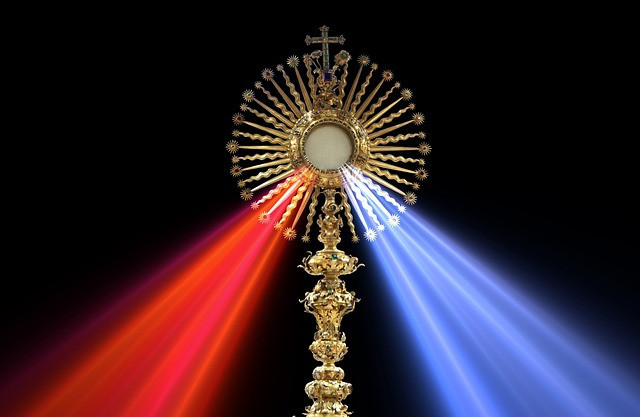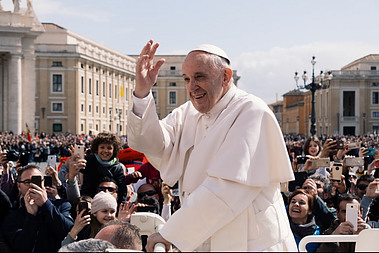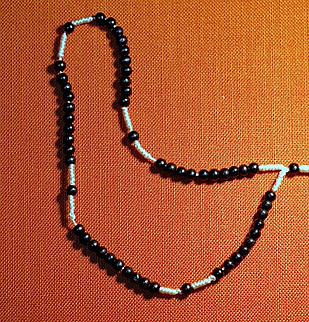
Here at rosarylovers.com, we don’t just love the Rosary. We love all things to do with Jesus Christ and Mary, including the Chaplet of Divine Mercy. Therefore, in this post, I would like to outline the Divine Mercy Chaplet prayer words for those of you thinking of practicing it.
An Introduction to the Divine Mercy Chaplet
I pray the Divine Mercy Chaplet sometimes. I always enjoy praying it and at times I pray it more than the Rosary in a single day.
The Divine Mercy Chaplet is much shorter to pray than the Rosary. In the fast-paced way of life of the West today, the Chaplet might be a more convenient devotion for many Catholics in the 21st century than the Rosary.
 Pope Francis is a particularly outspoken proponent of the Chaplet of Divine Mercy. He even offered a plenary indulgence during the COVID pandemic for those who would offer the Chaplet for those suffering and dying from COVID. This proves the Pope’s MASSIVE respect for this devotion.
Pope Francis is a particularly outspoken proponent of the Chaplet of Divine Mercy. He even offered a plenary indulgence during the COVID pandemic for those who would offer the Chaplet for those suffering and dying from COVID. This proves the Pope’s MASSIVE respect for this devotion.
Not to mention that Pope Francis has made the theme of Divine Mercy perhaps the central message of his Papal ministry.
St John Paul II was also a great respecter of the founder of the Divine Mercy Chaplet, St Faustina. St Faustina, her devotions, visions and teachings had very precarious and controversial history during the 20th century within the Church. But in 2000, St John Paul II made a firm stance on the Polish nun and her devotion to Divine Mercy by making her the first Saint of the 21st century.
Indeed, she is one of the greatest saints of modern times. I have written a post which includes details about her life and impact on the Church.
St John Paul II also established Divine Mercy Sunday. This was in fulfilment of the words our Lord spoke to St Faustina, that a great Feast would be instituted in the Church in honour of Christ’s Mercy.
Divine Mercy Sunday is such an important feast day in the Church that it is celebrated the Sunday after Easter, and gives a plenary indulgence to all who attend and perform some acts of mercy on this day.
In short, devotion to Divine Mercy is a highly popular devotion within the Catholic Church, and its popularity is getting greater as the years role on. There is every chance that in the future, the popularity of the Chaplet (and the indulgences attached to it) may become as great as that of the Rosary itself.
So how do you pray the Chaplet? And what words do you pray?
Use a Rosary
To pray the Chaplet of Divine Mercy, you are supposed to use a set of rosary beads. Have a look at this post to help you with this if you don’t have a rosary, because these ones are exceptional.
Beginning of Chaplet
You begin with the following prayers:
- The sign of the cross: ‘In the name of the Father, and of the Son, and of the Holy Spirit. Amen.‘
- The Lord’s prayer
- The Hail Mary
- The Apostles Creed
These prayers take place outside the circle of beads in the Rosary. You can pray them on the beads linked to the crucifix.
You may wish to offer this prayer also, but it’s optional: ‘O blood and water, which gushed forth from the heart of Jesus as a fountain of mercy for us, I trust in thee.‘
Prayer words within the Circle of Rosary beads
You now enter the circle of the Rosary. On the Our Father beads – the 5 isolated beads pictured below – you pray instead the following prayer:
 Eternal Father, I offer you the body and blood, soul and divinity of your dearly beloved Son, our Lord Jesus Christ, in atonement for our sins and for those of the whole world.
Eternal Father, I offer you the body and blood, soul and divinity of your dearly beloved Son, our Lord Jesus Christ, in atonement for our sins and for those of the whole world.
On the 10 Hail Mary beads clustered together, you instead pray:
For the sake of his Sorrowful Passion, have mercy on us and on the whole world.
So straight after the introduction prayers, you pray:
Eternal Father, I offer you … (as above)
Then you launch into saying 10 times: ‘For the sake of his Sorrowful Passion, have mercy on us and on the whole world.’
You don’t finish the decade with a Glory be.
After the 10th ‘For the sake of his Sorrowful Passion …‘, you again say on the Our Father rosary bead:
Eternal Father, I offer you the body and blood, soul and divinity … (as above).
You follow this simple formula of prayers right around the circle of the rosary until you get to the final bead.
So in total, you pray the ‘Eternal Father’ eucharistic prayer 5 times and you pray the ‘For the sake of his sorrowful passion’ prayer 50 times throughout the Chaplet.
Final prayers
Once you have prayed the 50th and final ‘For the sake of his Sorrowful Passion’, you finish with these words:
Holy God, Holy Mighty, Holy Immortal, have mercy on us and on the whole world
You say this a total of 3 times.
That is the end of the Chaplet, but you can finish with the sign of the cross if you wish, though this is optional.
Conclusion
The Divine Mercy Chaplet is a lot easier to learn than the Rosary, even though the Rosary is a devotion that is fairly easy to learn and very easy to practice. There are far fewer prayers to memorise with the Chaplet, and there are NO mysteries of the life of Christ to memorise.
This is because, in essence, the Chaplet of Divine Mercy is an extension of the Holy Sacrifice of the Mass, and is deeply connected to it and to the Passion of Jesus Christ on the Cross for us.
The Chaplet is, really, a deep and extended meditation upon and devotion to the Crucifixion of Jesus and his Mercy for us and the whole world.
The Chaplet is also an intercessory prayer for ourselves and the whole world.
So, the Rosary and the Chaplet have a lot of overlap in their intention, but they are two quite different prayers and devotions.
We might say that someone with a deep devotion to the Rosary will have a more obvious devotion to Mary and to the entire life of Jesus Christ. Someone with a deep devotion to the Chaplet of Divine Mercy, however, will have a more enhanced devotion to the divine Attribute of God’s Mercy, the Holy Eucharist and the Passion of Jesus.
Both of these devotions complement each other. Neither is more important than the other, and Catholics are free to make use of whichever they believe to be most helpful for their spiritual life, or even to ignore both and make use of another devotion or set of prayers.
Whatever devotion we follow, or even if we follow all sorts of devotions, let us never cease to pray daily to God for ourselves, for the Church and for all people.
If you have any questions, or would like to say something, please say it in the comments below.
God bless you through Mary, the Mother of Divine Mercy.